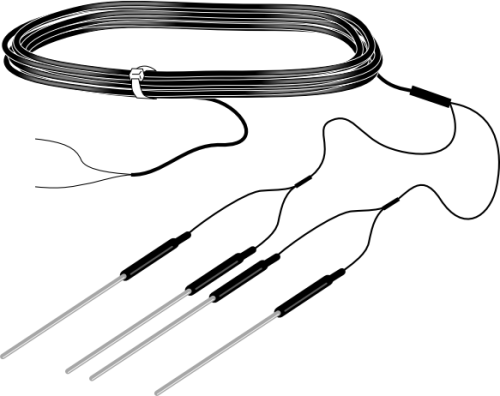
Visão Geral
The TCAV-L typically provides the average temperature of the top 6 to 8 cm of soil for energy-balance in flux systems. It parallels four thermocouples together into one 24 AWG wire. Each member of a thermocouple pair can then be buried at a different depth. The two pairs are separated at a distance of up to 1 m.
Leia maisBenefícios e Características
- Used in conjunction with soil heat-flux plates and soil-moisture probes to compute total soil heat flux
imagens

Descrição Técnica
The TCAV uses type E thermocouples, which are comprised of a chromel wire and a constantan wire joined at a measurement junction. A voltage potential is generated when the measurement end of the thermocouple is at a different temperature than the reference end of the thermocouple. The magnitude of the voltage potential is related to the temperature difference. Therefore, temperature can be determined by measuring the differences in potential created at the junction of the two wires.
A reference temperature measurement is required for thermocouple measurements. The temperature sensor built into many of our data loggers' wiring panel typically provides this measurement.
Compatibilidade
Please note: The following shows notable compatibility information. It is not a comprehensive list of all compatible products.
Data Loggers
| Product | Compatible | Note |
|---|---|---|
| CR1000 (retired) | ||
| CR1000X (retired) | ||
| CR3000 (retired) | ||
| CR6 | To obtain the highest accuracy, a high-accuracy junction measurement is required, such as that obtained using a 109 Temperature Probe or a GRANITE™ TEMP 120. | |
| CR800 (retired) | ||
| CR850 (retired) |
Additional Compatibility Information
Data Logger Considerations
One differential analog input channel per probe is required.
Reference Temperature Measurement
A reference temperature measurement is required. Options for measuring the reference temperature include:
- Thermistor built into the CR800, CR850, CR1000, CR3000, or CR5000 wiring panel
- PRT built into the wiring panel of the CR9050 or
- CR9051E input module for the CR9000X Measurement and Control Datalogger
- PRT built into the wiring panel of the CR723T input card for the CR7 Measurement and Control Datalogger
- CR10XTCR thermistor that connects to the CR10X wiring panel
Especificações
| Type | Chromel-Constantan |
| Typical Output | 60 μV/°C |
| Accuracy | Refer to the Thermocouple Measurement section in the data logger manual. |
| Weight | 0.45 kg (1 lb) with 15.24-m (50-ft) cable |
Documentos Relacionados
Perguntas Frequentes Relacionadas
Number of FAQs related to TCAV-L: 3
Expandir todosRecolher todos
-
Yes, as long as the TCAV-L is measured using a differential measurement instruction. Be sure to connect the shield wire to analog ground.
-
The TCAV-L measurement range, accuracy, and resolution are a function of the data logger used to measure the TCAV-L. Refer to the appropriate data logger manual measurement section for more information.
-
The TCAV-L is a Type E thermocouple. Use a Type E (chromel –constantan) Thermocouple found in the Sensor | Temperature group.
Estudos de Caso
Tropical volcanic islands are biodiversity hotspots where the Critical Zone (CZ) remains poorly studied. In......Leia mais
The Utah Geological Survey, supported by the Utah Division of Water Rights, has constructed a......Leia mais
This case study discusses the integration of CPEC310 and AP200 systems to explore the theories......Leia mais
Scientists and land-use managers have long recognized the importance of forest lands for their role......Leia mais
The Austin College Weather Station (ACWX) is located on Austin College's Sneed Environmental Research Area,......Leia mais







